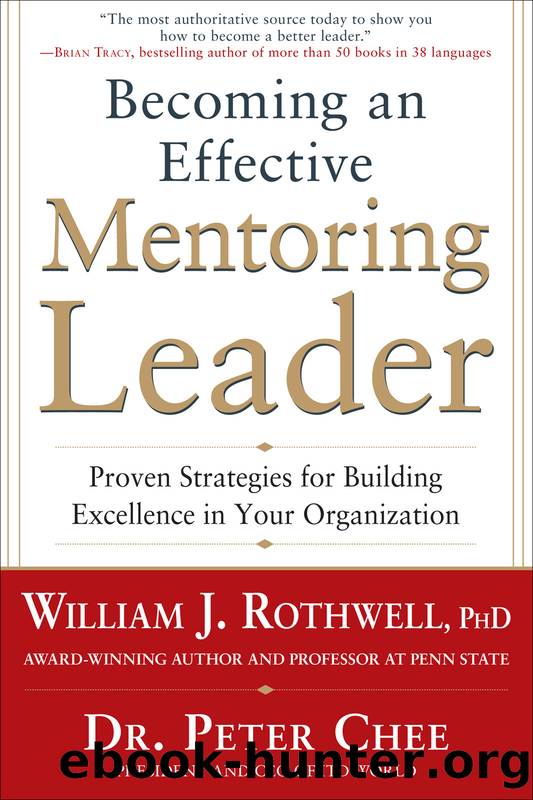Becoming an Effective Mentoring Leader by William J Rothwell & Peter Chee

Author:William J Rothwell & Peter Chee
Language: eng
Format: epub
Publisher: McGraw-Hill Education
Published: 2013-09-15T00:00:00+00:00
Modeling 2.0
We strongly believe that passive modeling can be improved, and we have improved it. We call our improved version Modeling 2.0 and it is the topic for the rest of this chapter.
A Brief Overview of Modeling 2.0
Task competence is a mentee goal common across mentoring relationships, which is not surprising as life (and work) is filled with tasks. Balancing a checkbook, planning a vacation, and conducting market research are all tasks. Modeling 2.0 is a mentoring method that is effective for teaching task competence.
Modeling 2.0 represents a synthesis of the good in modeling. It has retained all the traditional yet effective principles and practices. At the same time, steps have been taken to weed out the dubious passiveness that was described earlier. In other words, Modeling 2.0 is dynamic modeling. By âdynamic,â we mean that a meaningful interaction or interchange takes place between the mentor and mentee, and this dynamism is evident throughout the method.
In Modeling 2.0, a mentee is deemed to have attained task competence when he or she is able to perform a particular task in a manner that meets the performance standards relevant to that task. The following true story illustrates this point.
Jane was a young doctor who wanted to become a pediatrician. (In many Commonwealth countries, doctors do not specialize immediately upon graduation.) She approached Doris, a senior pediatrician, for advice. Doris informed Jane that one of the tasks she would have to master was intubation. Intubation is an effective way to deal with serious breathing problems in newborn babies that could result in death if not dealt with immediately.
âYou will need to attend a training program first,â said Doris. âI will arrange for you to attend one as soon as possible,â she added.
Jane attended the training program and learned the theories. She also got to practice intubation on a mannequin. She did well in her training, and Doris was pleased with Janeâs evaluation results. Jane then asked when she would get a chance to perform an actual intubation.
âIn due time,â Doris answered. âThis is how itâs going to work. First, you will see me do two. Next is the âtestâ: you will do one with me watching you. If you pass the âtest,â you can then do it on your own. Is this a deal?â she asked. Jane responded in the affirmative.
Their discussion, however, ended with an interesting disclosure from Doris. âYou should know thisâhow I do intubation is different from what you learned during your training. I donât use the stylet [i.e., a gadget commonly used in intubation]. If you will recall, the stylet, when used improperly, can cause damage to the trachea [i.e., the windpipe].â Jane nodded in agreement: she did learn that during training. âIâve found a way to intubate without using the stylet. By not using it, we greatly reduce the potential damage to the trachea. I want you to intubate this way.â Jane just sat there and smiled intelligently. She didnât really know how to react. But in her mind, she was thinking these thoughts: I canât wait to learn and practice her technique.
Download
This site does not store any files on its server. We only index and link to content provided by other sites. Please contact the content providers to delete copyright contents if any and email us, we'll remove relevant links or contents immediately.
Hit Refresh by Satya Nadella(9041)
The Compound Effect by Darren Hardy(8818)
Change Your Questions, Change Your Life by Marilee Adams(7638)
Nudge - Improving Decisions about Health, Wealth, and Happiness by Thaler Sunstein(7622)
The Black Swan by Nassim Nicholas Taleb(7016)
Deep Work by Cal Newport(6888)
Daring Greatly by Brene Brown(6451)
Rich Dad Poor Dad by Robert T. Kiyosaki(6414)
Principles: Life and Work by Ray Dalio(6226)
Playing to Win_ How Strategy Really Works by A.G. Lafley & Roger L. Martin(5937)
Man-made Catastrophes and Risk Information Concealment by Dmitry Chernov & Didier Sornette(5926)
Digital Minimalism by Cal Newport;(5667)
Big Magic: Creative Living Beyond Fear by Elizabeth Gilbert(5616)
The Myth of the Strong Leader by Archie Brown(5429)
The Slight Edge by Jeff Olson(5353)
Discipline Equals Freedom by Jocko Willink(5289)
The Motivation Myth by Jeff Haden(5158)
Stone's Rules by Roger Stone(5027)
The Laws of Human Nature by Robert Greene(5003)
